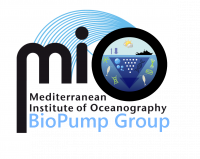Follow MIO MIO BioPump Group @MioBioPump
Steering Committee: S. Jacquet, L.E. Heimburger, Frederic Le Moigne (CEM); K. Leblanc, D. Lefèvre, S. Bonnet (CYBELE); B. Zakardian (OPLC); F. Armougom, C. Tamburini (SEM), D. Nérini (EMBIO)
Coordinator: C. Tamburini
The increase in atmospheric concentrations of CO2 (resulting from the combustion of fossil fuels) is affecting the global climate. The oceanic biological carbon pump (BCP), i.e. the production of biogenic carbon in the surface ocean, its subsequent export (particles flowing out of the sunlit layer of the ocean) and its remineralisation (transformation of organic CO2 into dissolved CO2) in the water column, is an important player in the climate system. Each year, the PCA reduces a flow of CO2 comparable in size to anthropogenic emissions (Henson et al., 2011). Consequently, any change in the strength of the BCP could exacerbate or mitigate climate change (Siegel et al. 2016).
In this context, it is crucial to better characterise the dynamics of organic matter (OM) production, export and remineralisation at the surface and at depth. The downward flow of exports is mainly controlled by a complex interaction of the surface microbial community, which controls the structure and particle size distribution of the particles (Guidi et al. 2009). Sinking organic particles represent remineralisation hotspots whose rates and mechanisms are poorly quantified (Tamburini et al. 2009, Riou et al. 2018), and then poorly or not represented in current biogeochemical models. Particle fluxes and dynamics in the Black Ocean are mainly measured using drifting and moored sediment traps, radionuclides or imaging techniques (McDonnell et al. 2015, Riley et al. 2012, Le Moigne et al. 2012). In other words, in the dark ocean, we are faced with a discrepancy between the estimated demand and supply of biological carbon (particle flux) (Steinberg et al. 2008, Burd et al. 2010, Herndl & Reinthaler 2013, Giering et al. 2014).
The aim of the MIO BioPump group (MIO Transverse Biological Pump Axis) is to question our understanding of the remineralisation of OM in the black ocean, as well as the basic ecology and metabolism of prokaryotic communities associated with sinking particles.
Significant results over the last five years and outlook for the future
Main publications over the last five years
Garel M, Bonin P, Martini S, Guasco S, Roumagnac M, Bhairy N, Armougom F, Tamburini C (2019) Pressure-retaining sampler and high-pressure systems to study deep-sea microbes under in situ conditions. Front Microbiol. In press. doi: 10.3389/fmicb.2019.00453
Riou V, Para J, Garel M, Guigue C, Ali B Al, Santinelli C, Lefèvre D, Gattuso J-P, Goutx M, Jacquet S, Moigne FAC Le, Tachikawa K, Tamburini C (2018) Biodegradation of Emiliania huxleyi aggregates by a natural Mediterranean prokaryotic community under increasing hydrostatic pressure. Prog Oceanogr 163:271-281. doi: 10.1016/j.pocean.2017.01.005
Lemaitre, N., Planquette, H., Planchon, F., Sarthou, G., Jacquet, S., García-Ibáñez, M. I., Gourain, A., Cheize, M., Monin, L., André, L., Laha, P., Terryn, H., and Dehairs, F. (2018). Particulate barium tracing of significant mesopelagic carbon remineralisation in the North AtlanticBiogeosciences, 15, 2289-2307, https://doi.org/10.5194/bg-15-2289-2018, 2018.
Jullion L., S. Jacquet , T. Tanhua (2017). Deconvolving biogeochemical processes from the impact of ocean circulation: first insight on the Mediterranean dissolved barium dynamics, Global Biogeochem. Cycles, 31, doi :10,1002/2016GB005489
Jacquet .H.M., F. Dehairs, D. Lefèvre, A.J. Cavagna, F. Planchon, U. Christaki, L. Monin, L. André, I. Closset and D. Cardinal (2015). Early spring mesopelagic carbon remineralization and transfer efficiency in the naturally iron-fertilized Kerguelen areraBiogeosciences, 12, 1713-1731, doi :10.518/bg-12-1713-2015
Giering SLC, Sanders R, Lampitt RS, Anderson TR, Tamburini C, Boutrif M, Zubkov M V, Marsay CM, Henson S a, Saw K, Cook K, Mayor DJ (2014) Reconciliation of the carbon budget in the ocean's twilight zone. Nature 507:480-483. doi: 10.1038/nature13123
Leblanc, K., Queguiner, B., Diaz, F., Cornet, V., Michel-Rodriguez, M., Durrieu de Madron, X., Bowler, C., Malviya, S., Thyssen, M., Gregori, G., Rembauville, M., Grosso, O., Poulain, J., de Vargas, C., Pujo-Pay, M., Conan, P., 2018. Nanoplanktonic diatoms are globally overlooked but play a role in spring blooms and carbon export. Nat Commun 9, 953.






